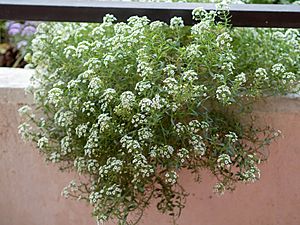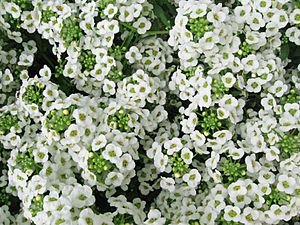Lobularia maritima facts for kids
Quick facts for kids Lobularia maritima |
|
|---|---|
 |
|
| Scientific classification | |
| Genus: |
Lobularia (plant)
|
| Species: |
maritima
|

Lobularia maritima is a beautiful, low-growing flowering plant. Most people know it as sweet alyssum or sweet alison. It used to be called Alyssum maritimum, which is why its common name is often just alyssum. This plant belongs to the Brassicaceae family, which also includes many vegetables like cabbage and mustard.
Contents
What's in a Name?
The name Lobularia comes from a Greek word. It means 'small pod', which describes the shape of the plant's fruits. The second part of its name, maritima, tells us something important. It means 'of the sea', because this plant loves to grow near coastal areas.
Plant Description
Sweet alyssum is usually an annual plant. This means it grows, flowers, and produces seeds all in one year, then dies. Sometimes, it can live a bit longer, like a short-lived perennial plant. It typically grows between 5 to 30 centimeters (about 2 to 12 inches) tall. It can spread out to be about 20 to 30 centimeters (8 to 12 inches) wide.
This plant has many branches with lots of tiny flowers. Its leaves are small, about 1 to 4 centimeters long and 3 to 5 millimeters wide. They are oval-shaped and can be a bit hairy.
Flowers and Seeds
The flowers are tiny, only about 5 millimeters (0.2 inches) across. They smell sweet, a bit like honey! Most sweet alyssum flowers are white. However, you can also find them in pink, rose-red, violet, yellow, and lilac colors. Each flower has four round petals and four sepals (small leaf-like parts that protect the bud).
Sweet alyssum flowers bloom for a long time. In places where it never freezes, they can bloom all year round. Insects help pollinate these flowers, which means they help the plant make seeds. After flowering, the plant produces many small, hairy seedpods. Each pod holds two seeds. The wind helps spread these seeds to new places.
Where It Grows
This plant is originally from the Mediterranean region and the Macaronesia islands. This includes places like the Canary Islands, Madeira, and Cape Verde. But sweet alyssum has spread and now grows naturally in many other parts of the world. You can find it in temperate areas, including the United States. There's even a special type of sweet alyssum that only grows on the Columbretes Islands in the western Mediterranean Sea.
Where It Likes to Live
Sweet alyssum is very common on sandy beaches and sand dunes. But it's also tough enough to grow in other places. You might see it in gardens, on old walls, on slopes, or in empty lots. It prefers soil that contains calcium, like limestone. It can grow from sea level up to about 300 meters (about 980 feet) high.
Growing Sweet Alyssum
Many people grow Lobularia maritima in their gardens. There are many different types (called varieties or cultivars) with purple or pink flowers. It's best to plant it in early spring. This plant is quite easy to care for once it starts growing.
Even though it's an annual plant, it can often reseed itself in places with mild weather. This means new plants will grow from the seeds of the old ones. If you trim off the flowers that have already bloomed, the plant will produce even more new flowers!
Sweet alyssum is often used as a groundcover in gardens. This means it grows low and spreads out, covering the ground like a carpet. It usually doesn't grow taller than 20 centimeters (about 8 inches). It also looks great growing in cracks in paving or walls, especially in coastal areas. It likes a bit of shade and can handle heat and dry conditions well. Plants with darker flowers tend to do better in cooler weather.
Popular Types (Cultivars)
Here are some popular types of sweet alyssum that gardeners like to grow. Some of these have won awards for being great garden plants:
- 'Snow Cloth' (white)
- 'Royal Carpet' (purple)
- 'Benthamii'
- 'Carpet of Snow'
- 'Easter Bonnet Violet'
- Golf Series agm
- 'Little Dorrit'
- 'Navy Blue'
- 'New Carpet of Snow'
- 'Oriental Nights'
- 'Rosie O’Day' agm
- 'Snow Crystals'
- 'Snowdrift' agm
- 'Sweet White'
- 'Tiny Tim'
- 'Violet Queen' agm
- 'Wonderland Copper'
- 'Wonderland White' agm
Uses of the Plant
Did you know that parts of the sweet alyssum plant can be eaten? The petals, leaves, and soft stems can be eaten raw or cooked.
Gallery
See also
 In Spanish: Lobularia maritima para niños
In Spanish: Lobularia maritima para niños






